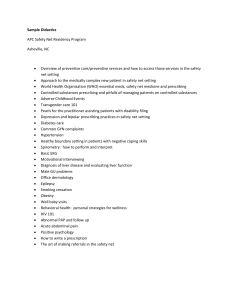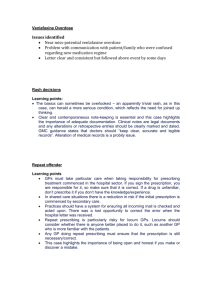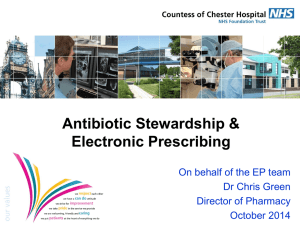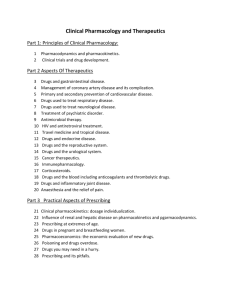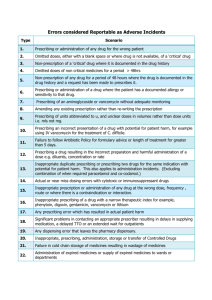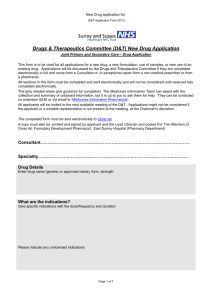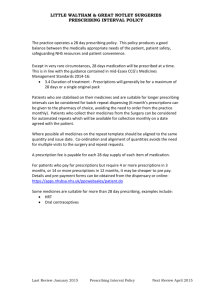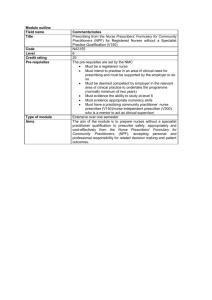2. Practice of Prescribing Competences
advertisement
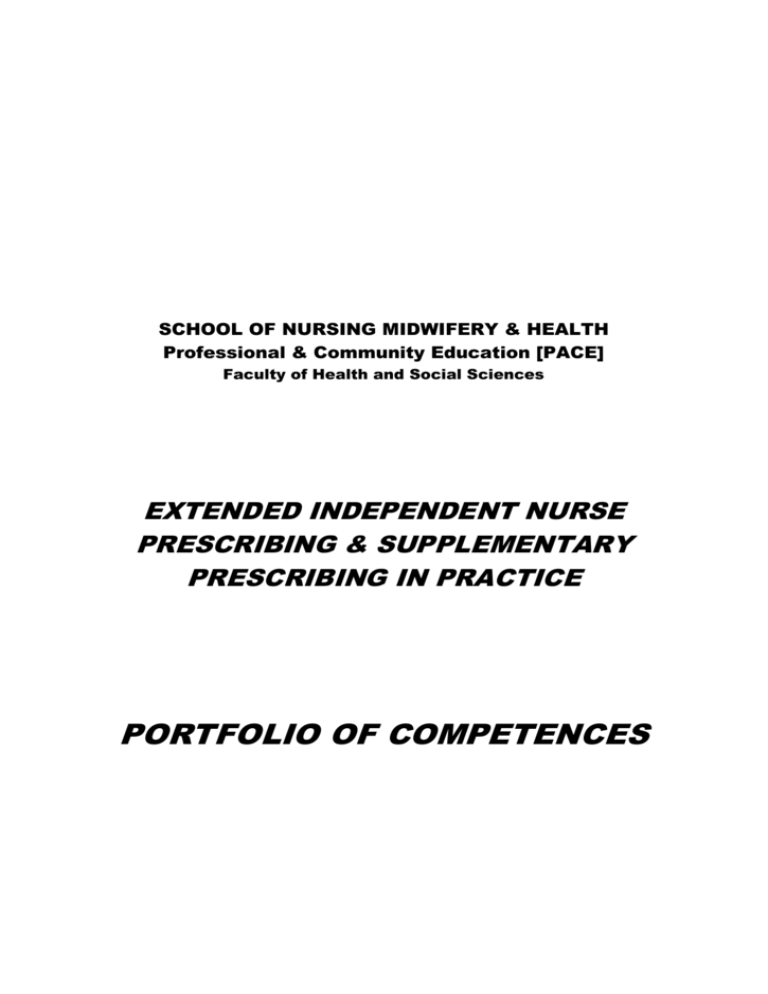
SCHOOL OF NURSING MIDWIFERY & HEALTH Professional & Community Education [PACE] Faculty of Health and Social Sciences EXTENDED INDEPENDENT NURSE PRESCRIBING & SUPPLEMENTARY PRESCRIBING IN PRACTICE PORTFOLIO OF COMPETENCES Acknowledgements The work of the following people is acknowledged in the development and production of this document: Diane Fotheringham, Nurse Lecturer, for her competence workbook resources. Jane Harris, seconded NBS Professional Officer, for expert advice regarding all aspects of the course development. Nan Stalker, Associate Head of School, for her reviewing of the document. BSc in Nursing/ Health Studies Extended Independent Nurse Prescribing and Supplementary Prescribing in Practice Module Co-requisite with Extended Independent Nurse Prescribing and Supplementary Prescribing Theoretical Module For further information, please contact Programme Leader: Anita Neilson University of Paisley School of Nursing, Midwifery & Health Paisley. PA1 2 BE. Tel: 0141 849 4215 Fax:0141 849 4203 e-mail: anita.neilson@paisley.ac.uk University of Paisley. 2002. Revised edition 2003. CONTENTS Page Number Acknowledgements 2 Background 4 Rationale for Completing Competences Portfolio 6 Guidance Notes on Compiling Portfolio 8 Competence Assessment 9 Reflective Practice 10 Portfolio of Competences 13 Learning Contract 14 Practice Supervision Logbook 15 Prescribing Competences 16 Completion of Portfolio Documentation 47 APPENDIX – Performance Evaluation Report 48 1. BACKGROUND The University of Paisley recognised the need to provide training for district nurses and health visitors in order that they could prescribe independently from a limited formulary. This training commenced in 1998 with the 2-day [plus prior open learning] limited independent nurse prescribing course and continues to run to meet the needs of the service providers. Following the recommendations of the Crown report [DoH, 1999], the independent nurse prescribing formulary was extended, subsequently allowing opportunities for trained nurses to prescribe. The extended formulary will cover four main areas of practice: Minor injuries Minor ailments Health promotion Palliative care. Government health departments announced in late 2002 that supplementary prescribing should now be added to the existing course with the appropriate course modifications. The University of Paisley has developed an extended independent nurse prescribing and supplementary prescribing course that meets the requirements of the NMC, and therefore has been validated by the NES. The course leads to a professional award to practice as an independent extended nurse prescriber and supplementary prescriber, and provides the learner with a total of 30 SCOTCAT points at level 3 on completion of the two component modules. There are two modules, one of theory and one of practice. The modules must be taken consecutively as the components of each module are interrelated and codependant. The two modules together can be taken as part of the BSc in Nursing degree programme or as stand-alone modules. The aim of this course is to prepare nurses, midwives and health visitors to prescribe from the Nurse Prescribers’ Extended Formulary as an independent prescriber and by using patient specific clinical management plans as a supplementary prescriber. The learning outcomes from the combined modules will allow the nurse to: Understand the importance of assessing patients and be aware of health assessment models and frameworks. Be able to assess patients and appropriately prescribe medications safely and cost-effectively. Gain knowledge of medications and be able to critically evaluate their use in prescribing practice. Understand and apply knowledge of medications and critically evaluate use in prescribing practice. Demonstrate teamwork and communication skills in making decisions in prescribing practice, and demonstrate competence in prescribing, supplying, administering and evaluating effects of medications. Be aware of the relevant legislation and how to apply it in a professional and accountable manner. Understand the differences between Patient Group Directions and patient specific Clinical Management Plans and be able to apply this knowledge in practice. References: Dept. of Health. 1999. Review of Prescribing, Supply and Administration of Medicines. DOH. London. NMC Circular 25/2002Extended Independent Nurse Prescribing and Supplementary Prescribing. 2. RATIONALE FOR COMPLETING COMPETENCES PORTFOLIO This Portfolio of Competences makes up part of the assessment for the course. The student nurse prescriber will use this portfolio as evidence of achieving competence in prescribing practice. The learner must complete 12 days [72 hours] of supervised practice, usually in his or her own work area. The practice experience will mainly relate specifically to the medical conditions and situations that the individual nurse is most likely to be presented with in their own working environment. The learner will have a designated prescribing supervisor, who has already given their written consent on the nurse’s application for entry, to act in this capacity for the duration of the course. The supervisor is mutually responsible with the student for identifying the learning opportunities for the achievement of the competences. A learning contract will be written and an action plan will be agreed upon to meet the learning needs of the nurse prescriber. The principle areas and relevant knowledge base required by the NMC [2002] to underpin the practice of prescribing are divided into 4 areas: Principle area Knowledge base The Principles of Prescribing Legislation that underpins prescribing Team working principles and practice Philosophy and psychology of prescribing The Practice of Prescribing Current clinical and pharmaceutical knowledge Principles of drug dosage, side effects, reactions and interactions Communication, consent and concordance Relationship of public health requirements to prescribing Accountability in Prescribing The Code of Professional Conduct The lines of accountability at all levels for prescribing Drug abuse and potential for misuse Requirements of record keeping Lines of communication Responsibility in Prescribing Leadership skills Roles of other prescribers Relationships of prescribers to pharmacists Clinical governance requirements in prescribing practice Audit trials to inform prescribing Reference: NMC Circular 25/2002. Extended Independent Nurse Prescribing and Supplementary Prescribing. 3. GUIDANCE NOTES ON COMPILING PORTFOLIO This portfolio should be kept in a ring-binder folder, and your evidence can be added into the folder on separate sheets beside the competence that it is relevant to. Do not place evidence in plastic covers; instead insert punch holes and put all information directly into the folder. When compiling the evidence for your competences, you may wish to work through the following stages with your prescribing supervisor: 3.1 Review the competence What knowledge do you require to achieve this competence? 3.2 Set your learning objectives What do you want to achieve? 3.3 Develop an action plan What learning activities will help you meet your needs? What resources do you need access to? What members of the multidisciplinary prescribing workforce do you need to communicate with? 3.4 Implement the action plan Negotiate any study time required. 3.5 Evaluate what happened What was the outcome? Was the competence achieved? Do you need to develop an alternative plan? How did your patient/ client feel? What did you learn from the experience? How will your practice change as a result? 3.6 Record your evidence Keep an evidence sheet of the time you spend on each task. This will help you keep a record as evidence of the 12 days or 72 hours of practice required to complete the module. 4. COMPETENCE ASSESSMENT 4.1 The nurse prescriber is being assessed on his/ her competency at each prescribing principle, and on the knowledge and practice demonstrated to attain it. 4.2 Students should be graded 0-5 on each competence as follows: X – Not assessed. 0 – Unacceptable. The student is unable to perform to acceptable standards in most situations. Persistent need for cues necessary. 1 – Poor. The student performs this activity to a barely acceptable standard. Can only carry out the task once shown or by trial and error. Does not demonstrate understanding of underlying principles. 2 – Average. This implies that the student can perform acts, which have become habitual and can be performed with some degree of confidence and proficiency. The student demonstrates basic understanding of underpinning principles. 3 – Good. The student performs this activity to an above average standard in most situations. The student can perform the task skilfully, usually quickly and smoothly and with certainty and co-ordination. Demonstrates a good understanding of underlying theory and an ability to analyse. 4 – Very good. The student always performs to a high standard. This implies that the student’s skills are so well developed that they can modify the task to fit special requirements or to meet a problem situation. 5 – Outstanding. The student always performs to the highest possible standards. The student develops creativity and highly developed skills. 4.3 All 30 competences must be assessed and the nurse prescriber must achieve a minimum of grade 2 in all competences. 4.4 Requests for an extension beyond the date stated on the timetable should be applied for in writing before the submission date [as per University guidelines]. Extension requests should also be signed by the prescribing supervisor. Please state how long will be required and reason for request. Please note extensions beyond stated date may delay completion of course date and subsequent notification to NMC. 5. REFLECTIVE PRACTICE "Reflection in the context of learning is a generic term for those intellectual and affective activities in which individuals engage to explore their experiences in order to lead to new understanding and appreciations." Boud et al. 1985. We all reflect on or in our practice. Whether we do it informally, for example by discussing a client’s care with other members of the multidisciplinary team or peers, or formally - by writing a description of an incident or situation and then analysing it in detail. No matter how you do it, reflective practice is an essential part of our learning process and can be of great value to you when you are assessing your practice for competency. Although there is great debate about whether or not theoretical models should be used to guide reflection, there is the argument that whilst moving from novice to expert, guided structures for reflection can help initially, but on which dependency lessens as the learner gains more experience [Benner, 1984]. Various models can guide reflection both in action and on actions. Schon’s [1983] description of reflecting in action encompasses the concept that students should be guided to review their experience under supervision and questioning from an expert. However, this does not negate the benefit of reflecting on the actions past, where more time can be spent critically analysing the situation, researching and critiquing the relevant literature and accessing the expertise from the working team. An existentialist view, if you look at a phenomenological nursing [understanding the human situation] approach, can give insight for the reflective practitioner on how their actions can affect others, and questions how the experience can be made better through a staged analysis. Step 1 A preliminary coming to know through the acquisition or calling to mind of relevant information or knowledge Step 2 Intuitive knowing of the other: perceiving the other in the other's own terms Step 3 Scientific knowing of the other through a consideration, analysis, synthesis and, finally, conceptualisation of the subjective experience Step 4 Comparison and synthesis of like situations in order to deepen the understanding of the encounter Step 5 Drawing together into a unique whole, which is the situation: the expression of the lived experience. [Paterson and Zderad 1996] Carper [Johns, 1995] tries to create a balance between theory and experience with her Ways of Knowing Model for reflection: Empirics, Ethics, Personal Aesthetics, and Reflexivity. Under each heading the learner is guided through questioning themselves by reflection on each of the questions raised under these headings. Certainly, Johns [1995] suggests that reflection must be guided “to facilitate learning and understanding through reflection” as well as provide a structure for both the learner and supervisor to develop practice in their own roles and to monitor their own performance. However, Reid [1994] warns us of the problem of mentors being so enthused by their own reflections that the learner ends up lost in their expert analysis of the situation. It is worth considering the use of a model for reflection if, at the novice level, you find you are floundering when attempting to critically analyse your actions and make justifications for your decisions. There are many models available, but it is essential that you choose one that you understand and will facilitate your learning. Discuss the use of a model with your prescribing supervisor or university liaison tutor, and research the literature well before making your choice. There are clear benefits of reflective practice and this can be made use of when obtaining evidence for achieving each of the competences. Every prescription that you write can form an incident from which you can: analyse and reflect on your actions use problem-solving skills communicate with others in your decision-making examine the policies and underpinning knowledge, which will guide your actions consider the moral and ethical issues that may arise enhance your empathy of others enhance professional behaviour be aware of your accountability and responsibility as a professional. References: Benner, P. 1984. From Novice to Expert: Excellence and Power in Clinical Nursing Practice. Addison-Wesley. Boud, D et al. 1985. Reflection: Turning Experience into Learning. Kogan Page. Johns, C. 1995. Framing learning through reflection within Carper’s fundamental ways of knowing in nursing. Journal of Advanced Nursing. 22. 2. 226 –234. Paterson and Zderad. 1996, from Fernandez, E. 1997.Just 'doing the observations': reflective practice in nursing. BJN. Vol6 No.16. Reid, B. 1994. The mentor’s experience – a personal perspective. In Reflective Practice in Nursing. Palmer, A. et al. Editors. Blackwell Science. Schon, D. 1983. The Reflective Practitioner: How Professions Think in Action. Basics Books. PORTFOLIO OF COMPETENCES NURSE PRESCRIBER DETAILS NAME: ………………………………………………………………….. PRESENT POST: ………………………………………………………………….. GRADE: ………………………………………………………………….. PLACE OF WORK: ………………………………………………………………….. ………………………………………………………………….. ………………………………………………………………….. Tel No ………………………………………………………………….. Email ………………………………………………………………….. UKCC/ NMC pin No: ………………….. Matriculation No:…………………… PRESCRIBING SUPERVISOR DETAILS Name of Prescribing Supervisor: ……………………………………………………… Place of Work: ………………………………………………………………….. Contact No: ………………………………………………………………….. Email: ………………………………………………………………….. UNIVERSITY LIAISON TUTOR DETAILS Name of Tutor: ………………………………………………………………….. Place of Work: ………………………………………………………………….. Contact No: ………………………………………………………………….. Email: ………………………………………………………………….. LEARNING CONTRACT This contract is to enable the nurse prescribing student and the prescribing supervisor to identify learning opportunities for the student and plan the appropriate learning experience. Using the Competence List as a guide, please write down your learning needs and compile and action plan for each identified need. You can photocopy this page as required. Identified Learning Needs: Action Plan: Resources required: Review: Summary: Prescribing Supervisor: ……………………………………………………………… Nurse Prescriber: ……………………………………………………………… Date: ……………………………………………………………… PRACTICE SUPERVISION LOGBOOK The total time in supervised practice must add up to 12 days or 72 hours. Evidence of the type of supervised practice should be briefly explained in the logbook and the duration of the activity recorded. This page can be photocopied. Date Description of actions supervised Duration Total Prescribing Competences 1. Principles of Prescribing Competences 1.1 Works within the legislative framework relevant to the area of practice and locality. 1.2 Aware of the impact of prescribing in the wider delivery of care. 1.3 Works and communicates as part of a multidisciplinary prescribing workforce. 1.4 Understands the complexity of the external demands and influences on prescribing. 1.5 Is able to use the adverse reaction reporting mechanisms. 1.6 Understands the principles behind supplementary prescribing and how they are applied to practice. 1.7 Reviews diagnosis and generates treatment options within the clinical management plan. 2. Practice of Prescribing Competences 2.1 Is aware of policies that have an impact on public health and influence prescribing practice. 2.2 Works with patients and clients as partners in treatment. 2.3 Makes an accurate assessment and diagnosis and can generate treatment options. 2.4 Uses up to date clinical and pharmaceutical knowledge relevant to own area of expertise. 2.5 Applies knowledge of medications in prescribing practice. 2.6 Assesses when to prescribe or when to make appropriate referral. 2.7 Refers back to a medical practitioner when appropriate. 2.8 Understands how medicines are licensed and monitored. 2.9 Prescribes, safely, appropriately and cost effectively. 2.10 Is able to articulate the boundaries of prescribing in relation to the duty of care to patients and society. 3. Accountability in Prescribing Competences 3.1 Knows the code of conduct and can apply the principles of accountability to prescribing practice. 3.2 Is able to account for the cost and effects of prescribing practice. 3.3 Understands where and how to access and use patient/ client records. 3.4 Writes and maintains coherent records of prescribing practice. 3.5 Communicates effectively with patients, clients and professional colleagues. 3.6 Assesses risk to the public of inappropriate use of prescribed substances. 3.7 Regularly reviews evidence behind therapeutic strategies. 4. Responsibility in Prescribing Competences 4.1 Articulates and understands the roles of other key stakeholders in prescribing practice. 4.2 Advises and guides peers in the practice of prescribing. 4.3 Understands the requirements of pharmacists in the prescribing and supply process. 4.4 Links prescribing practice with evidence base, employer requirements and local formularies. 4.5 Demonstrates ability to audit practice. 4.6 Can undertake reflective practice and identify continuing professional development needs. 1. Principles of Prescribing Competences 1.1 Works within the legislative framework relevant to the area of practice and locality. Description of summary of evidence gathered which indicates competency. Aware of the legislative history of nurse prescribing, as outlined in case study appendix 1.This is included overleaf, and focuses on law, accountability, duty of care and indemnity. Within the body of the case study this is contextualised by relating these principles to working practice via local policy and procedures. This part of the case study is reproduced overleaf also. Student’s Comments Assessor’s Comments Overall Grade Achieved: …………………………….…………… Achieved on date: ……………………………….………… Nurse Prescriber: ……………………………………….… [Signature] Prescribing Supervisor: …………………………………….…… [Signature] 1. Principles of Prescribing Competences 1.2 Aware of the impact of prescribing in the wider delivery of care. Description of summary of evidence gathered which indicates competency. There is a long discussion of the multifactorial nature of depression in case study. The positives and negatives that supplementary nurse prescribing may bring to this is in the conclusion, and is précised over. Also, I discussed this with colleagues and a contact through the NES website Professor Peter Nolan, who sent me a transcript of a recent conference on this topic. I have also enclosed the email discussion as evidence. Student’s Comments Assessor’s Comments Overall Grade Achieved: …………………………….…………… Achieved on date: ……………………………….………… Nurse Prescriber: ……………………………………….… [Signature] Prescribing Supervisor: …………………………………….…… [Signature] 1. Principles of Prescribing Competences 1.3 Works and communicates as part of a multidisciplinary prescribing workforce. Description of summary of evidence gathered which indicates competency. I am a CPN and a member of the multidisciplinary older person’s mental health team. I am (generally) the nurse representative at the weekly reviews (and allocations for new referrals). From a specifically medical perspective I hold regular (monthly ) reviews with one of the team consultant psychiatrists. The other attends the team reviews also. This psychiatrist is the independent prescriber in the clinical management plan. I also have close links with community pharmacists. One kindly allowed me to watch him work for a morning! The other provides all the dosette boxes as required for my caseload. Student’s Comments Assessor’s Comments Overall Grade Achieved: …………………………….…………… Achieved on date: ……………………………….………… Nurse Prescriber: ……………………………………….… [Signature] Prescribing Supervisor: …………………………………….…… [Signature] 1. Principles of Prescribing Competences 1.4 Understands the complexity of the external demands and influences on prescribing. Description of summary of evidence gathered which indicates competency. The evidence contains a response by Alzheimer’s society to NICE recommendations threatening imminent curtailing of NHS prescribing of cholinesterase inhibitors, on the grounds of cost. It summarises the economic debate nicely, and highlights broad political issues surrounding prescribing generally. I have also researched this aspect of prescribing in some detail, and have had contact with Professor Nolan in this regard. The email correspondence is enclosed, which resulted in his sending me a conference paper on the subject. Student’s Comments Assessor’s Comments Overall Grade Achieved: …………………………….…………… Achieved on date: ……………………………….………… Nurse Prescriber: ……………………………………….… [Signature] Prescribing Supervisor: …………………………………….…… [Signature] 1. Principles of Prescribing Competences 1.5 Is able to use the adverse reaction reporting mechanisms. Description of summary of evidence gathered which indicates competency. I am aware of having to report all adverse reactions on ‘black triangle’ drugs (ie, any adverse or unexpected event, however minor, which could conceivably be attributed to the drug (BNF, 2005)). However, suspected adverse reactions to any therapeutic agent should also be reported. Overleaf is a completed ‘yellow card’ in respect to a suspected adverse reaction to mirtazipine. Student’s Comments Assessor’s Comments Overall Grade Achieved: …………………………….…………… Achieved on date: ……………………………….………… Nurse Prescriber: ……………………………………….… [Signature] Prescribing Supervisor: …………………………………….…… [Signature] 1. Principles of Prescribing Competences 1.6 Understands the principles behind supplementary prescribing and how they are applied to practice. Description of summary of evidence gathered which indicates competency. The case study is written from the perspective of the student supplementary prescriber. The principles are explained by the attached flowcharts, ie when to use PGDs, independent or supplementary prescribing, and a section of the case study applying these principles in practice is then used as evidence to demonstrate this competency, along with the attendant clinical management plan. Student’s Comments Assessor’s Comments Overall Grade Achieved: …………………………….…………… Achieved on date: ……………………………….………… Nurse Prescriber: ……………………………………….… [Signature] Prescribing Supervisor: …………………………………….…… [Signature] 1. Principles of Prescribing Competences 1.7 Reviews diagnosis and generates treatment options within the clinical management plan. Description of summary of evidence gathered which indicates competency. The clinical management plan is included overleaf, which indicates the dosage range agreed by the supplementary prescriber and the independent prescriber, ie 20-40mg Citalopram. It also specifies review periods for both prescribers. It likewise specifies specific instances for review outwith these specified times, namely: Drowsiness, inefficacy, postural drop and renal complication Student’s Comments Assessor’s Comments Overall Grade Achieved: …………………………….…………… Achieved on date: ……………………………….………… Nurse Prescriber: ……………………………………….… [Signature] Prescribing Supervisor: …………………………………….…… [Signature] 2. Practice of Prescribing Competences 2.1 Is aware of policies that have an impact on public health and influence prescribing practice. Description of summary of evidence gathered which indicates competency. The evidence attached describes a short history of the legislation driving nurse prescribing, and the case study conclusion attempts to draw together some of the broader socio-political influences affecting nurse prescribing at present. Student’s Comments Overall Grade Achieved: …………………………….…………… Achieved on date: ……………………………….………… Nurse Prescriber: ……………………………………….… [Signature] Prescribing Supervisor: …………………………………….…… [Signature] 2. Practice of Prescribing Competences 2.2 Works with patients and clients as partners in treatment. Description of summary of evidence gathered which indicates competency. Clinical Management Plan. This would describe the range and scope of potential supplementary prescribing in detail. In this case we would assess Bob’s mood subjectively and objectively using our existing therapeutic relationship in conjunction with validated measuring tools such as GDS (Sheik and Yesavage 1984). We would jointly agree if a change in therapy was warranted, and I would prescribe accordingly. Signed consent form. Vital to the process of single shared assessment. Signed consent indicates patient agreement and understanding of the multidisciplinary approach to information sharing within health and social care, and the legal requisite to acknowledge this agreement.get consent form Student’s Comments Assessor’s Comments Overall Grade Achieved: …………………………….…………… Achieved on date: ……………………………….………… Nurse Prescriber: ……………………………………….… [Signature] Prescribing Supervisor: …………………………………….…… [Signature] 2. Practice of Prescribing Competences 2.3 Makes an accurate assessment and diagnosis and generates treatment options Description of summary of evidence gathered which indicates competency. From a broader perspective than just prescribing this is discussed in detail in the case study. The objective assessment tool of choice is the Geriatric Depression Scale (GDS) (Sheikh and Yesavage, 1986), which is included over, but accurate assessment and treatment is based on a wider understanding of depression, its components, and current research discussions on efficacy. A short précis is also summarised from the case study. From a specifically prescribing perspective, please see clinical management plan supporting competencies 1.1 and 1.6, which clarifies treatment options within the range of Citalopram prescribing. Student’s Comments Assessor’s Comments Overall Grade Achieved: …………………………….…………… Achieved on date: ……………………………….………… Nurse Prescriber: ……………………………………….… [Signature] Prescribing Supervisor: …………………………………….…… [Signature] 2. Practice of Prescribing Competences 2.4 Uses up to date clinical and pharmaceutical knowledge relevant to own area of expertise. Description of summary of evidence gathered which indicates competency. I understand the history of psychotropic medication research, which better frames current rational approaches to drug development. This is discussed in the evidence, along with a brief discussion on how NICE (2004) arrived at their decision to suggest the SSRIs as first line medication for moderate to severe depression. BNF (2005) take a more pragmatic approach. Student’s Comments Assessor’s Comments Overall Grade Achieved: …………………………….…………… Achieved on date: ……………………………….………… Nurse Prescriber: ……………………………………….… [Signature] Prescribing Supervisor: …………………………………….…… [Signature] 2. Practice of Prescribing Competences 2.5 Applies knowledge of medications in prescribing practice. Description of summary of evidence gathered which indicates competency. The clinical management plan specifies the dosage and potential side effects, which may ensue following prescription of citalopram. The case study also describes some cautions and contraindications listed in the BNF (2005), along with acknowledging the potential problems associated with polypharmacy. Also, caution should always be used in prescribing for the elderly, particularly when the individual has a history of renal complications. The clinical management plan is in evidence 1.1, and pharmacology of SSRIs in 2.4. A small excerpt from the case study which discusses decisions specific to the case study is overleaf. Student’s Comments Assessor’s Comments Overall Grade Achieved: …………………………….…………… Achieved on date: ……………………………….………… Nurse Prescriber: ……………………………………….… [Signature] Prescribing Supervisor: …………………………………….…… [Signature] 2. Practice of Prescribing Competences 2.6 Assesses when to prescribe or when to make appropriate referral. Description of summary of evidence gathered which indicates competency. Any incidence, side effect, drug interaction or other anomaly occurring outwith the scope of the clinical management plan should be referred back to the independent presriber. The supplementary nurse presriber is acting within the scope of their competence if they prescribe within the spirit and letter of the plan. Student’s Comments Assessor’s Comments Overall Grade Achieved: …………………………….…………… Achieved on date: ……………………………….………… Nurse Prescriber: ……………………………………….… [Signature] Prescribing Supervisor: …………………………………….…… [Signature] 2. Practice of Prescribing Competences 2.7 Refers back to a medical practitioner when appropriate. Description of summary of evidence gathered which indicates competency. Within the spirit of the clinical management plan these boundaries are clearly specified. In respect of any other issues regarding medication I would follow existing protocol ie, if it is outwith my scope of knowledge and clearly problematic I would contact the relevant professional. The nurse must always practice in a safe, lawful and professionally accountable manner (NMC,2005). A good example of some of these instances is in the asthma flowchart. Student’s Comments Assessor’s Comments Overall Grade Achieved: …………………………….…………… Achieved on date: ……………………………….………… Nurse Prescriber: ……………………………………….… [Signature] Prescribing Supervisor: …………………………………….…… [Signature] 2. Practice of Prescribing Competences 2.8 Understands how medicines are licensed and monitored. Description of summary of evidence gathered which indicates competency. Student’s Comments Assessor’s Comments Overall Grade Achieved: …………………………….…………… Achieved on date: ……………………………….………… Nurse Prescriber: ……………………………………….… [Signature] Prescribing Supervisor: …………………………………….…… [Signature] 2. Practice of Prescribing Competences 2.9 Prescribes, safely, appropriately and cost effectively. Description of summary of evidence gathered which indicates competency. As I deal primarily with over 65s, prescription costs are nil to the clients, and therefore this is not normally an issue. However, a brief discussion of the cost and responsibility in advising the purchase of over the counter medications is discussed in relation to the nurse’s duty of care, which naturally covers aspects of safety and appropriateness of prescribing. Student’s Comments Assessor’s Comments Overall Grade Achieved: …………………………….…………… Achieved on date: ……………………………….………… Nurse Prescriber: ……………………………………….… [Signature] Prescribing Supervisor: …………………………………….…… [Signature] 2. Practice of Prescribing Competences 2.10 Is able to articulate the boundaries of prescribing in relation to the duty of care to patients and society. Description of summary of evidence gathered which indicates competency. The evidence contains a discussion on the links between duty of care, indemnity and accountability in relation to the history of nurse prescribing. The case study also briefly discusses Sarah Mullally’s (2004) proposal that nurse prescribing should be a mandatory prerequisite to a further NMC registered qualification of ‘advanced nurse’. This would further clarify the boundaries associated with advanced autonomy. Meanwhile, the boundaries are explicitly framed in local guidelines subsuming the NMC’s existing position on the duty of care. Student’s Comments Assessor’s Comments Overall Grade Achieved: …………………………….…………… Achieved on date: ……………………………….………… Nurse Prescriber: ……………………………………….… [Signature] Prescribing Supervisor: …………………………………….…… [Signature] 3. Accountability in Prescribing Competences 3.1 Knows the code of conduct and can apply the principles of accountability to prescribing practice. Description of summary of evidence gathered which indicates competency. I am an experienced nurse approaching an area in which I have no experience. This reduces me to the level of '‘novice'’within the area of prescribing, according to Benner (1984). Whether one accepts this model or not the notion is effective in framing my current competence level, and I would not therefore act beyond it. In other words, I am aware of my limitations and would not prescribe outwith the scope of my clinical competence. This will change with experience, but accountability is sustained throughout (NMC, 2005). Student’s Comments Assessor’s Comments Overall Grade Achieved: …………………………….…………… Achieved on date: ……………………………….………… Nurse Prescriber: ……………………………………….… [Signature] Prescribing Supervisor: …………………………………….…… [Signature] 3. Accountability in Prescribing Competences 3.2 Is able to account for the cost and effects of prescribing practice. Description of summary of evidence gathered which indicates competency. The evidence contains a graph illustrating comparative prescription costs for various analgesics. There is no evidence to suggest that NSAIDs are any more effective than paracetamol, and they are more expensive and carry increased risk of GI disturbance. There is also a section from ISD Scotland breaking down national trends and costs of current prescribing patterns in NHS Student’s Comments Assessor’s Comments Overall Grade Achieved: …………………………….…………… Achieved on date: ……………………………….………… Nurse Prescriber: ……………………………………….… [Signature] Prescribing Supervisor: …………………………………….…… [Signature] 3. Accountability in Prescribing Competences 3.3 Understands where and how to access and use patient/ client records. Description of summary of evidence gathered which indicates competency. As a CPN working across 17 different GP surgeries this is not straightforward. Even within the older person’s mental health team different professions use different case notes, though this is under review. Online case files will hopefully eradicate some of these issues, but this process is difficult due mainly to incompatible data systems and security issues With respect to prescribing, as with existing formal communication, I would write a letter to the GP detailing supplementary prescription changes within the clinical management plan. Following discussion with the independent prescriber, we have decided on the template attached for this purpose. With regards to accessing information, I generally use the psychiatric notes held by the consultants, who likewise write to the respective GPs to inform them of medication changes. NEED EVIDENCE!! GET TEMPLATE!! Student’s Comments Assessor’s Comments Overall Grade Achieved: …………………………….…………… Achieved on date: ……………………………….………… Nurse Prescriber: ……………………………………….… [Signature] Prescribing Supervisor: …………………………………….…… [Signature] 3. Accountability in Prescribing Competences 3.4 Writes and maintains coherent records of prescribing practice. Description of summary of evidence gathered which indicates competency. There is a prescription for paracetamol 1000mg four times a day overleaf. The prescription is also recorded in the nursing notes, and a letter is sent to the GP in order to align databases, communicate change and evidence that communication. Student’s Comments Assessor’s Comments Overall Grade Achieved: …………………………….…………… Achieved on date: ……………………………….………… Nurse Prescriber: ……………………………………….… [Signature] Prescribing Supervisor: …………………………………….…… [Signature] 3. Accountability in Prescribing Competences 3.5 Communicates effectively with patients, clients and professional colleagues. Description of summary of evidence gathered which indicates competency. Clinical management plan is evidence of this, along with the discussion with the client on his subjective view regarding his illness (précis in evidence). Signed consent is always gained with regard to multidisciplinary care where information will be shared, and a copy of a consent form is also included. Student’s Comments Assessor’s Comments Overall Grade Achieved: …………………………….…………… Achieved on date: ……………………………….………… Nurse Prescriber: ……………………………………….… [Signature] Prescribing Supervisor: …………………………………….…… [Signature] 3. Accountability in Prescribing Competences 3.6 Assesses risk to the public of inappropriate use of prescribed substances. Description of summary of evidence gathered which indicates competency. The evidence shows a brief case study of a lady with a long history of anxiety related somatic symptoms, and a label of ‘hypochondria’. She has been treated over the years with various medications from benzodiazepines and betablockers to antidepressants ancient and modern and ECT. She is currently taking effervescent co-codamol for pain, which is not recommended due to its high sodium content. Given that she is also prescribed an antihypertensive she is advised against this. There is a short discussion about western consumption of salt, and its impact on physical health. Student’s Comments Assessor’s Comments Overall Grade Achieved: …………………………….…………… Achieved on date: ……………………………….………… Nurse Prescriber: ……………………………………….… [Signature] Prescribing Supervisor: …………………………………….…… [Signature] 3. Accountability in Prescribing Competences 3.7 Regularly reviews evidence behind therapeutic strategies Description of summary of evidence gathered which indicates competency. In advising Mary to stop taking effervescent co-codamol, I am expressing a well evidenced opinion. The case study covers the world health authority position on salt consumption, and discusses some cost implications as well as connecting this evidence to other studies on sodium and hypertension. The study concludes that this evidence shapes the local formulary position as described by Argyll and Clyde drug formulary (2003) to exercise caution in prescribing this preparation, particularly in regard to people with a history of hypertension. Student’s Comments Assessor’s Comments Overall Grade Achieved: …………………………….…………… Achieved on date: ……………………………….………… Nurse Prescriber: ……………………………………….… [Signature] Prescribing Supervisor: …………………………………….…… [Signature] 4. Responsibility in Prescribing Competences 4.1 Articulates and understands the roles of other key stakeholders in prescribing practice. Description of summary of evidence gathered which indicates competency. Overleaf is a flowchart detailing some decisions made when patient group directions are considered. This is relevant as it includes many stakeholders at a practical level. From a broader perspective there is a brief discussion of the protocols involved in prescribing at the end of evidence for 1.1, which includes the influence of national policy and politics on local guidelines. There is a more detailed discussion earlier in the evidence (for 1.1.) http://www.druginfozone.nhs.uk/pgd/PGd-Flowchart_v5_2004.pdf Student’s Comments Assessor’s Comments Overall Grade Achieved: …………………………….…………… Achieved on date: ……………………………….………… Nurse Prescriber: ……………………………………….… [Signature] Prescribing Supervisor: …………………………………….…… [Signature] 4. Responsibility in Prescribing Competences 4.2 Advises and guides peers in the practice of prescribing. Description of summary of evidence gathered which indicates competency. www.notnow.co.uk contains all my personal study for this course, and this site is available for browsing by my colleagues and peers. Student’s Comments Assessor’s Comments Overall Grade Achieved: …………………………….…………… Achieved on date: ……………………………….………… Nurse Prescriber: ……………………………………….… [Signature] Prescribing Supervisor: …………………………………….…… [Signature] 4. Responsibility in Prescribing Competences 4.3 Understands the requirements of pharmacists in the prescribing and supply process. Description of summary of evidence gathered which indicates competency. Student’s Comments Assessor’s Comments Overall Grade Achieved: …………………………….…………… Achieved on date: ……………………………….………… Nurse Prescriber: ……………………………………….… [Signature] Prescribing Supervisor: …………………………………….…… [Signature] 4. Responsibility in Prescribing Competences 4.5 Links prescribing practice with evidence base, employer requirements and local formularies. Description of summary of evidence gathered which indicates competency. The evidence contains an evidence based case study describing the multi-factorial nature of ‘health anxiety’ and how it manifests itself in a client of mine. It links this presentation to the current thinking surrounding treatment options of this condition, the roles adopted by various professionals over the years, and specifically focuses on the somatic nature of Mary’s presentation. It especially describes some of the thinking behind current local formulary development, and refers to their position in specific regard to prescription of effervescent cocodamol in patients with hypertension. Student’s Comments Assessor’s Comments Overall Grade Achieved: …………………………….…………… Achieved on date: ……………………………….………… Nurse Prescriber: ……………………………………….… [Signature] Prescribing Supervisor: …………………………………….…… [Signature] 4. Responsibility in Prescribing Competences 4.5 Demonstrates ability to audit practice. Description of summary of evidence gathered which indicates competency. Audit can be achieved through clinical supervision, and a copy of reflection is included for competence 4.6. More objectively however, standardised validated psychometric evaluation can be achieved, and hence medication efficacy monitored, through use of the geriatric depression scale. A copy of this is enclosed, and it’s place in audit demonstrated through a précis of the relevant case study section. Student’s Comments Assessor’s Comments Overall Grade Achieved: …………………………….…………… Achieved on date: ……………………………….………… Nurse Prescriber: ……………………………………….… [Signature] Prescribing Supervisor: …………………………………….…… [Signature] 4. Responsibility in Prescribing Competences 4.6 Can undertake reflective practice and identify continuing professional development needs. Description of summary of evidence gathered which indicates competency. I have a clinical supervision contract with a fellow nurse prescriber, so we can discuss our expanding role on a practical level, given that this is new to both of us. We undertake regular team reviews. I have also (under Agenda for Change) just updated my job description, and regularly discuss my continuing professional development with my manager. I have no formal process for this at present but know this is a ‘work in progress’. So far my recent development appears to have benefited the team as well as myself by being directly relevant to it’s overall aim. Student’s Comments Assessor’s Comments Overall Grade Achieved: …………………………….…………… Achieved on date: ……………………………….………… Nurse Prescriber: ……………………………………….… [Signature] Prescribing Supervisor: …………………………………….…… [Signature] COMPLETION OF PORTFOLIO DOCUMENTATION All 30 competences have been achieved A total of 12 days or 72 hours of supervised practice has been completed. The profile has been completed and contains all the relevant documentation as evidence. NURSE PRESCRIBER Comments: Signature:…………………………………………………. Date:……………………. PRESCRIBING SUPERVISOR Comments: Signature:…………………………………………………. Date:……………………. UNIVERSITY LIAISON TUTOR Comments: Signature:…………………………………………………. Date:……………………. APPENDIX Performance Evaluation Report Please photocopy the following 4 pages and use the following form when attaining competences under the supervision of an agent other than your Prescibing Supervisor. PORTFOLIO OF COMPETENCES - Performance Evaluation Report The supervising agent should use this sheet. The report should then be given to the student for submission to their Prescribing Supervisor for endorsement of this competence. Please use the grading system attached. This form should be photocopied for use during each seconded placement. Student Nurse Prescriber: Prescribing Supervisor: Place of work: Competence to be achieved: ………………………………………………….. ………………………………………………….. ………………………………………………….. Number.……………………………………….. Description of summary of evidence gathered which indicates competency: Student’s comments: Supervising agent’s comments: Prescribing supervisor’s comments: Overall Grade Achieved: …………………………………………..……… Achieved on date: …………………………………………..……… Number of hours in placement: …………………………………………..……. Supervising agent: …………………………………………..………[Signature] Position …………………………………………..……… Practice area …………………………………………..……… Nurse Prescriber: …………………………………………..……… [Signature] Prescribing Supervisor: ……...…………………………………..……..…[Signature] COMPETENCE ASSESSMENT The nurse prescriber is being assessed on his/ her competency at each prescribing principle, and on the knowledge and practice demonstrated to attain them. Students should be graded 0-5 on each competence as follows: X – Not assessed. 0 – Unacceptable. The student is unable to perform to acceptable standards in most situations. Persistent need for cues necessary. 1 – Poor. The student performs this activity to a barely acceptable standard. Can only carry out the task once shown or by trial and error. Does not demonstrate understanding of underlying principles. 2 – Average. This implies that the student can perform acts, which have become habitual and can be performed with some degree of confidence and proficiency. The student demonstrates basic understanding of underpinning principles. 3 – Good. The student performs this activity to an above average standard in most situations. The student can perform the task skilfully, usually quickly and smoothly and with certainty and co-ordination. Demonstrates a good understanding of underlying theory and an ability to analyse. 4 – Very good. The student always performs to a high standard. This implies that the student’s skills are so well developed that they can modify the task to fit special requirements or to meet a problem situation. 5 – Outstanding. The student always performs to the highest possible standards. The student develops creativity and highly developed skills. The nurse prescriber must achieve a minimum of grade 2 in the competence. Examples of evidence required for competence achievement Additional sheets should be added to encompass some of the evidence as listed below. This will help the assessor grade the competence. Should additional written evidence be required to substantiate this competence, then this should be documented at the appropriate place on page 2 by the either the supervising agent, the prescribing supervisor or both. Further sheets of A4 can be added if necessary . o Description of event - what happened at the patient consultation? Describe your structured your approach to elicit information from the patient; i.e. how you took an appropriate history by asking pertinent questions. Describe how you developed a working diagnosis and formulated a management plan with the patient. o Analysis of the event. What internal and external factors influenced your decision? What options were available to you? What evidence-based knowledge did you use to make a decision? What previous situations did you refer to when making your decisions? Were there any legal or ethical implications to consider? o Resources accessed to make a decision [referenced to or photocopies of policies, guidelines, formularies, etc]. o Evidence of liaison with multi-disciplines [minutes of meetings, brief summary of discussions, referral requests]. o Evaluation of event. Describe the outcome. Did you make the right choice? Would you have changed anything? What did you learn from the event? Were there any alternative choices you could have made?
